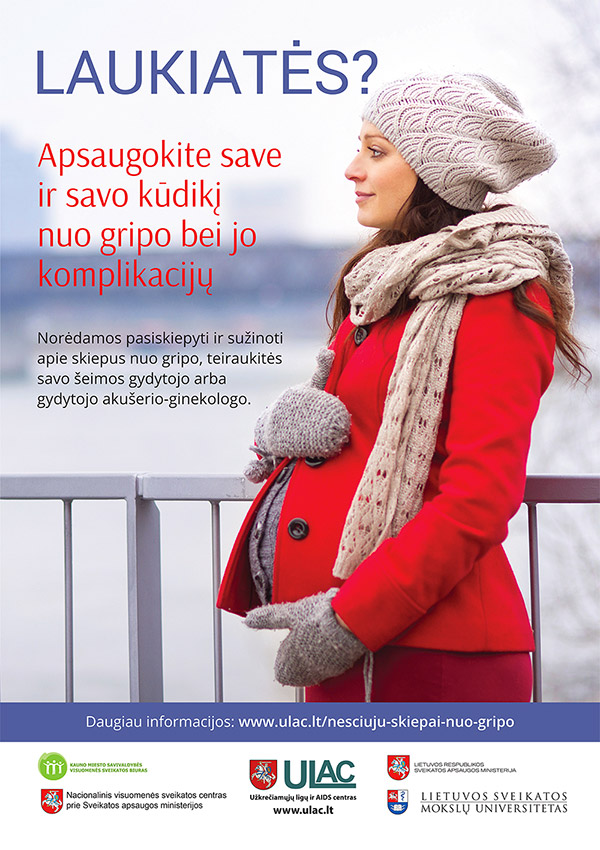The World Health Organisation named pregnant women as the top priority risk group for flu vaccination in 2012. The vaccine can safely protect mothers and babies from flu, and has been shown to reduce the risk of stillbirth.
However, it can take time for this message to reach the public and health professionals.
Some European countries still have particularly low rates of flu vaccination during pregnancy. In Lithuania, for example, uptake is close to zero. This is in stark contrast to strong childhood immunisation rates.
So, what’s the problem?
Health authorities in Kaunas, Lithuania’s second largest city, teamed up with experts from the WHO Regional Office for Europe to pilot a promising approach to improving vaccination rates. Tailoring Immunization Programmes (TIP) was developed by WHO/Europe to help devise context-specific ways to improve vaccine uptake.
Rather than a one-size-fits-all campaign to improve vaccination uptake, TIP has been used to create tailored campaigns for poorly vaccinated population sub-groups, including Roma communities in Bulgaria, anthroposophic communities in Sweden and ultraorthodox Jewish communities in the UK.
‘Over the last 10 to 15 years, there has been growing appreciation of the need to address the barriers and enablers of vaccination and to develop strategies based on that,’ says Katrine Bach Habersaat, Technical Officer, Vaccine-preventable Diseases and Immunization, WHO Regional Office for Europe. ‘Drawing on social science research methods, the TIP approach enables us to develop more effective and more cost-effective strategies to increase vaccination uptake.’
Case study: Kaunas
When it comes to improving vaccination rates, pregnant women are a challenging group for several reasons. There is a natural caution about what to eat and drink during pregnancy, and no shortage of advice online – some evidence-based, some not. Protecting the child is usually a priority and there is little tolerance for risk, whether perceived or real.
In some countries, flu vaccination during pregnancy is almost unheard of. Rates of flu vaccination during pregnancy in Kaunas, Lithuania, were around 0.5% in 2012. Applying the TIP Flu approach, WHO and Kaunas health officials identified a number of barriers to flu vaccine uptake and several opportunities for improving immunisation rates. Rather than relating to vaccine-specific hesitancy, several were practical issues that could be addressed through training and other changes to the system.

One of the most immediate tasks was to bring healthcare providers up to speed with the recommendation on flu vaccination during pregnancy, helping them to engage with pregnant women on the topic.
‘Flu vaccination was never part of the antenatal care conversation,’ Pernille Jorgensen, an epidemiologist at the WHO Regional Office for Europe. ‘In addition, obstetricians and gynaecologists – in whom women place a lot of trust – are not authorised to administer vaccines.’
The latter legislative issue has not yet been changed but there was still plenty of scope for improving flu vaccination rates by working with healthcare providers.
Training for healthcare workers was provided during the pilot programme and items about flu vaccination were added by the Ministry of Health of the Republic of Lithuania to a ‘pregnancy card’ which reminds healthcare providers to address several important issues during antenatal visits.
While these measures take more resources than classic communication strategies – such as advertising and placing posters in clinics, which are also used – it empowers doctors and nurses to be proactive in discussing the protective benefits of flu vaccination during pregnancy.
The pilot programme produced some encouraging results. From a very low starting point of 0.2% in Kaunas city, overall uptake rose to 3.3% in 2015-2016, and to 4.5% in 2016-2017.
The highest coverage in Kaunas city in the season of 2016- 2017 was reached in Kaunas Central Policlinics were 22% of registered pregnant women have been vaccinated against influenza. While there is still room for improvement, the pilot showed the merits of the TIP approach. ‘It proves that if you go and look at what the barriers and enablers are, you can tailor a programme to suits the target group,’ says Jorgensen.
View from Kaunas
For health authorities in Kaunas, TIP Flu presented an opportunity to bring together various organisations around a unified goal.
‘Thanks to input from family doctors and gynaecologists, as well as nurses, obstetricians, and public health specialists, seasonal flu vaccination of pregnant women is substantially increasing,’ says Orina Ivanauskienė, Head of the Communicable Diseases Management Division, Kaunas Department, National Public Health Centre. ‘Having access to more evidence-based information, made healthcare workers more confident when recommending flu vaccination to pregnant women.’
The experience of Kaunas has also impacted flu vaccination rates of pregnant women in other territories of Lithuania too. Specialists from the Kaunas Department of the National Public Health Centre have strongly encouraged peers to consider applying the TIP Flu approach in other regions of Lithuania.
‘For greater uptake of vaccination – not only of pregnant women but children and other risks groups – more attention should be given to the implementation of communication campaigns,’ Ivanauskienė says.




